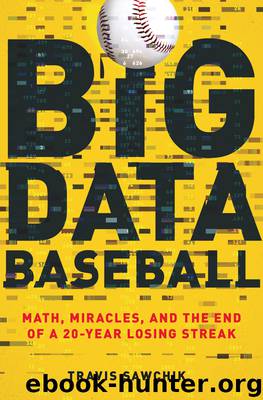Big Data Baseball by Travis Sawchik

Author:Travis Sawchik [Sawchik, Travis]
Language: eng
Format: epub
ISBN: 9781250063519
Publisher: Flatiron Books
Published: 0101-01-01T00:00:00+00:00
Like Morton, Burnett’s pitch mix radically changed with the Pirates. And like Morton, Burnett’s results also evolved. Burnett’s ground-ball rate soared. He went from posting a below-average ground-ball rate in all three of his seasons in New York to the game’s second-highest ground-ball rate—56.9 percent—among qualifiers in 2012. He began to resemble the dominant pitcher he was earlier in his career.
That Searage and Hurdle could get buy-in from Morton was one thing. Morton was an amiable, thoughtful pitcher in need of help. That Searage and Hurdle could get buy-in from Burnett was remarkable. Burnett was a stubborn, headstrong veteran who had had success. He could be difficult to manage. His own teammate and friend Jeff Locke told the Tribune-Review there was “A.J.” and there was “J.A.” The J.A. was for “jackass.” But somehow Searage and Hurdle were able to connect with all sorts, from the headstrong and macho Burnett to the analytical Morton. If they could get buy-in from Burnett and Morton, from both poles of the cooperation spectrum, could they get buy-in from everyone else?
Communication was key with the pitching philosophy. And the philosophy wasn’t just about throwing a lot more two-seam fastballs, it was also about location. Pirates pitchers were told they were not just going to change what they threw, they were going to change where they threw. Unlike the shifts and pitch-framing philosophies, where the data was discovered or produced at the top of the front office and delivered down to the coaching staff and players, the third prong of the run-prevention strategy, the approach on the mound, was driven from the bottom up.
Hurdle wanted and needed his assistant coaches to be on board and feel ownership of this entire philosophy: from the defensive alignment to the pitching plan. That’s the only way the effect would be maximized. He wanted his assistants to feel empowered. He wanted there to be collaboration. Hurdle asked the coaches and pitchers to buy in to the three-pitches-or-less doctrine. Searage and Benedict were on board with some of the concepts, they had their own ideas to add, and they had questions. Hurdle wanted his assistants—from Leyva to Searage—to ask questions. Hurdle didn’t want to just hand down orders. He wanted his assistants to improve the big-picture plan. That would foster a sense of ownership and improve commitment and execution. Hurdle preached to his players, coaches, and front office staff that “We’re trying to all get it right together.” During the off-season and that spring, Hurdle wanted his staff to think of ways to enhance the plan, to test and share theories, and to make these plans better and more refined. More than anything else, he wanted them to ask questions of not just him but of the analytics staff, which was sending down an avalanche of data from the front office. He wanted his coaching staff to have the analytics staff test theories the coaches had, not just subscribe to those handed down to them. He wanted the coaches and analytics team to respect each other.
Download
This site does not store any files on its server. We only index and link to content provided by other sites. Please contact the content providers to delete copyright contents if any and email us, we'll remove relevant links or contents immediately.
Machine Learning at Scale with H2O by Gregory Keys | David Whiting(3640)
Never by Ken Follett(3533)
Liar's Poker by Michael Lewis(3228)
The Ultimate Backcountry Survival Manual by Aram Von Benedikt; Editors of Outdoor Life;(3172)
Will by Will Smith(2581)
The Partner by John Grisham(2286)
Can't Hurt Me: Master Your Mind and Defy the Odds - Clean Edition by David Goggins(2004)
Friends, Lovers, and the Big Terrible Thing by Matthew Perry(1998)
Taste by Kris Bryant(1803)
HBR's 10 Must Reads 2022 by Harvard Business Review(1698)
A Short History of War by Jeremy Black(1671)
Never Finished: Unshackle Your Mind and Win the War Within by David Goggins(1558)
The Arm by Jeff Passan(1522)
515945210 by Unknown(1521)
The Dodgers by Schiavone Michael;(1477)
The Yogi Book by Yogi Berra(1426)
443319537 by Unknown(1395)
A Game of Thrones (The Illustrated Edition) by George R. R. Martin(1373)
1942266391 (N) by Monte Francis(1372)
